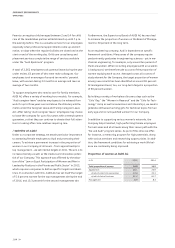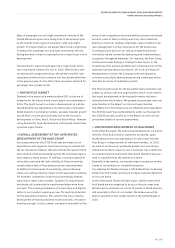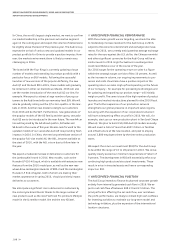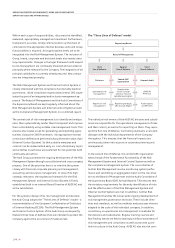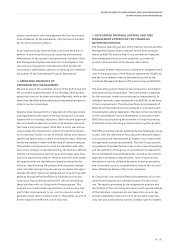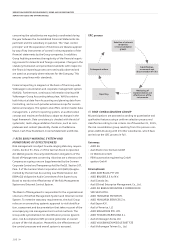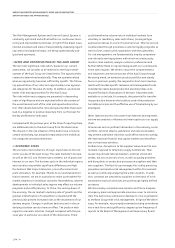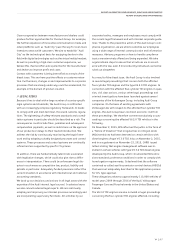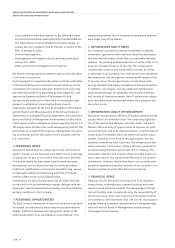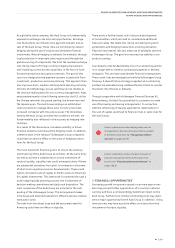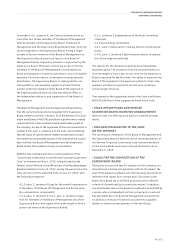Audi 2015 Annual Report Download - page 194
Download and view the complete annual report
Please find page 194 of the 2015 Audi annual report below. You can navigate through the pages in the report by either clicking on the pages listed below, or by using the keyword search tool below to find specific information within the annual report.
REPORT ON EXPECTED DEVELOPMENTS, RISKS AND OPPORTUNITIES
REPORT ON RISKS AND OPPORTUNITIES
194 >>
The Risk Management System and Internal Control System is
constantly optimized and refined within our continuous moni-
toring and improvement processes. In light of the diesel issue,
internal processes and areas of responsibility, especially regard-
ing control and approval steps, are being systematically ana-
lyzed and optimized.
/RISKS AND OPPORTUNITIES OF THE AUDI GROUP
The ten most significant risks which, based on our current
assessment, we consider to be material to the future devel-
opment of the Audi Group are listed below. The opportunities
stated are determined analytically. They are operationalized
when an opportunity becomes sufficiently specific. The follow-
ing presentation of our risks and opportunities uses appropri-
ate categories for the sake of clarity. In addition, we indicate
latent risks and opportunities for the Audi Group.
The risks within each category are presented in descending
order of significance and are explained within the context of
the overall assessment of the risks and opportunities situa-
tion. We indicate below the risks and opportunities that could
lead to a negative or positive departure from our forecast for
the key performance indicators.
Compared with the previous year, at the time of reporting there
are additional risks to the Audi Group from the diesel issue.
The impact on the risk situation of the Audi Group is not pre-
sented collectively, but assigned separately to the individual
risk categories and described there.
// ECONOMIC RISKS
The economic environment is of major importance to the eco-
nomic success of the Audi Group. The sales markets in Europe,
as well as the U.S. and Chinese sales markets, are of particular
interest in our case. The business cycle in the individual regions
and countries may exhibit significant differences and high
fluctuations that impact deliveries, price enforcement and
plant utilization, for example. Thanks to our worldwide distri-
bution network, we are in a position to make up elsewhere for
market weakness in individual countries. Nevertheless, adverse
developments in individual sales regions may affect our volume
programs and profit planning. In China, the cooling-down of
the economy, the car market’s declining rate of growth and the
gradual intensification of competition compared with the
previous year present increased risks to the attainment of our
delivery targets. Changes in political decisions and in the un-
derlying situation can also have an effect. The position with
regard to economic risks has changed compared with the pre-
vious year in particular as a result of the diesel issue. There
could therefore be volume risks in individual markets from
voluntary or mandatory sales restrictions, prolonged type
approval processes or a lack of customer trust. This risk is to be
counteracted through preventive customer loyalty programs as
well as close, constructive cooperation with the authorities.
For risk management, we fundamentally employ comprehen-
sive risk early warning systems with which we continuously
monitor sales markets, analyze customer preferences and
further define these in regular dialogue with our counterparts
in the sales regions. We seek to secure the competitiveness
and long-term commercial success of the Audi Group through
the strong brand, an attractive product portfolio and steady
focus on premium quality. We respond to short-term develop-
ments with market-specific measures and management tools.
Consistently needs-based production planning helps us to
respond flexibly to fluctuations in demand. Important tools
available to us include, for example, the potential for transfer-
ring production between the locations under the production
turntable principle and the effective use of timebanking by our
employees.
Other latent economic risks stem from external developments
that we are unable to influence and interruptions to our supply
chain.
Occurrences such as political intervention in the economy, social
conflicts, terrorist attacks, pandemics and natural disasters
may present additional risks that could affect economic activity,
the international financial and capital markets and therefore
also our business activities.
Furthermore, disruptions to the supplier network and its envi-
ronment may lead to temporary supply bottlenecks. Their
causes may include natural disasters, political unrest and
strikes, but also economic crises, as well as quality problems
and disruptions to production processes at suppliers and their
own suppliers. The Audi Group manages this risk by practicing
preventive and reactive risk management within Procurement
as well as continually analyzing the wider situation. In addi-
tion, contracts are awarded to suppliers on the basis of a risk
assessment and such decisions are put through rigidly defined
processes.
We also employ comprehensive scenario and future analyses,
emergency plans and appropriate insurance cover to minimize
risks. The Audi Group continues to develop its crisis organization
to reinforce Group-wide crisis management. In light of the diesel
issue, for example, we promptly extended existing committees
into a task force and significantly stepped up the frequency of
reports to the Board of Management and Supervisory Board.


